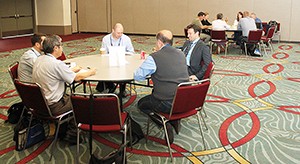 Pediatric tonsillectomy and adenoidectomy (TNA) is a common and usually uncomplicated surgery. But adding Down syndrome to the mix can add significant difficulties.
Pediatric tonsillectomy and adenoidectomy (TNA) is a common and usually uncomplicated surgery. But adding Down syndrome to the mix can add significant difficulties.
“Children with Down syndrome are more prone to sleep apnea and airway obstruction due to a large tongue, short neck and laryngomalacia,” said Catherine Seipel, M.D., Assistant Professor of Pediatrics and Anesthesiology at Baylor College of Medicine. “Manipulation of the neck for intubation and surgery should be performed very cautiously because of potential neck instability.”
Dr. Seipel presented a Problem-Based Learning Discussion (PBLD), “Tonsillectomy and Adenoidectomy in a Child with Down Syndrome: More to it Than You Think!” on Tuesday. TNA is among the most common interventions for sleep apnea in Down syndrome children. Complexities can begin as early as the first encounter in the exam room.
About 60 percent of children experience presurgical anxiety, and Down syndrome children are even more likely to be affected. Many have had prior surgeries and other unpleasant medical encounters as well as varying degrees of mental deficits.
Expect to spend extra time trying to establish some sort of rapport and calming these patients, Dr. Seipel suggested, and always take time to assess children for anxiety. If patients cannot be calmed by talking or distraction, premedication with benzodiazepines or alpha-2 agonists may help. Depending on hospital policy, it may also be helpful to have a parent accompany the child into the O.R. for induction.
The American Academy of Pediatrics recommends against routine cervical spine radiographs. That makes it more important to closely observe the patient for signs of neck instability. Typical signs and symptoms include gait instability, radiculopathy, and bowel or bladder incontinence.
If the child is not symptomatic, be cautious in neck manipulation, Dr. Seipel said. Other physicians, nurses, surgical technicians and health care providers should be cautioned to avoid excessive neck extension during the surgical and perioperative period.
If the child is symptomatic, he or she should have cervical spine imaging. If any abnormalities are seen, the patient should be referred to a pediatric neurosurgeon or orthopedic surgeon who specializes in atlantoaxial evaluation and management.
Bradycardia is common during induction of anesthesia in children with Down syndrome. If the heart rate does not recover, atropine may be useful. If an I.V. line is not in place, the drug can be injected sublingually for fast effect.
Many clinicians prefer to minimize the use of opioids in these patients, although a small amount of fentanyl at the end of surgery can provide analgesia as the patient wakes up. Dexamethasone, acetaminophen, dexmedetomidine and ibuprofen may also be useful alternatives to opioids.
TNA is a same-day procedure for many hospitals, but Down syndrome children should spend at least one night under observation, Dr. Seipel noted. Patients with increased risk for obstructive sleep apnea should not be discharged to an unmonitored setting until they are no longer at risk for respiratory depression.
